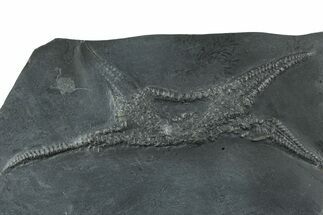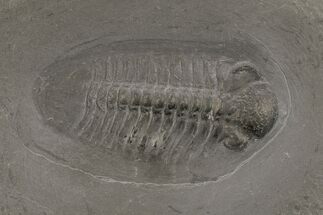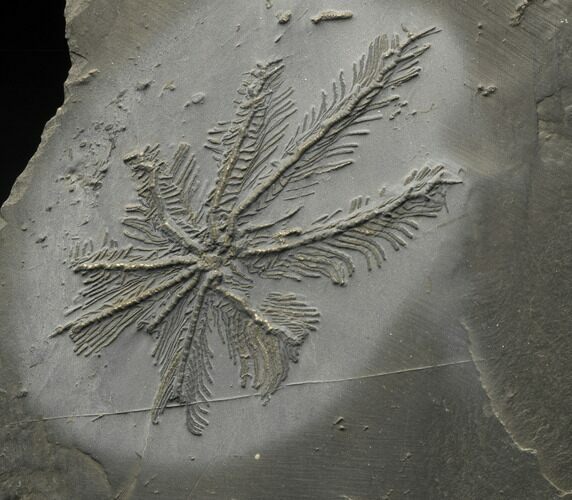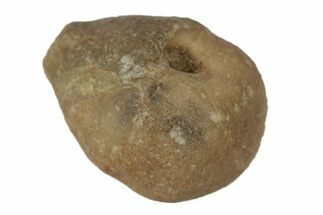This Specimen has been sold.
Museum Quality Hapalocrinus frechi (“Palm Tree Crinoid”)
This well-prepared specimen of Hapalocrinus frechi ("Palm Tree Crinoid) looks very much alive, with so much minute detail present and the high relief makes this fossil very impressive. The Hunsruck Slates of Bundenbach, Germany are now protected sites and the once numerous quarries have been closed to collecting. The only way to acquire a fossil from this famous location is to find one - like this fine piece - from an old collection.
The lower Devonian (lower Emsian) slates from Bundenback have been quarried for roofing material for centuries. Quarrying continued until the 1960s, when the competition from cheaper synthetic or imported slate resulted in production decline. The last pit closed in 2000. Mining of Hunsrück slate was important for the discovery of Paleozoic fossils. Although not rare, fossils can only be found through extensive mining of slate and time consuming preparation. The Bundenbach “Hunsruck Slate is famous for yeilding one of the most important assemblages of Paleozoic fossils, including 260 animal species. This includes many mollusks, arthropods and echinoderms like this gorgeous Crinoid specimen.
Crinoids resemble a flower with tentacles. They are filter feeders and have feather-like appendages that strain food particles from the ocean currents. Some live as floating organisms but most are attached to the ocean floor by the means of a segmented stem. The calyx is the body and contains the digestive and reproductive parts. The tentacles contain feathery appendages called cirri which moved the captured food particles down towards the calyx and into the mouth. Most fossilized crinoids are found disarticulated in beds of countless fragments but they can be found in articulated forms as they once were when alive.
The lower Devonian (lower Emsian) slates from Bundenback have been quarried for roofing material for centuries. Quarrying continued until the 1960s, when the competition from cheaper synthetic or imported slate resulted in production decline. The last pit closed in 2000. Mining of Hunsrück slate was important for the discovery of Paleozoic fossils. Although not rare, fossils can only be found through extensive mining of slate and time consuming preparation. The Bundenbach “Hunsruck Slate is famous for yeilding one of the most important assemblages of Paleozoic fossils, including 260 animal species. This includes many mollusks, arthropods and echinoderms like this gorgeous Crinoid specimen.
Crinoids resemble a flower with tentacles. They are filter feeders and have feather-like appendages that strain food particles from the ocean currents. Some live as floating organisms but most are attached to the ocean floor by the means of a segmented stem. The calyx is the body and contains the digestive and reproductive parts. The tentacles contain feathery appendages called cirri which moved the captured food particles down towards the calyx and into the mouth. Most fossilized crinoids are found disarticulated in beds of countless fragments but they can be found in articulated forms as they once were when alive.
SPECIES
Hapalocrinus frechi
LOCATION
Bundenbach, Germany
FORMATION
Hunsrück Slate
SIZE
Crinoid 3" long
CATEGORY
SUB CATEGORY
ITEM
#14654
We guarantee the authenticity of all of our specimens.
 Reviews
Reviews











